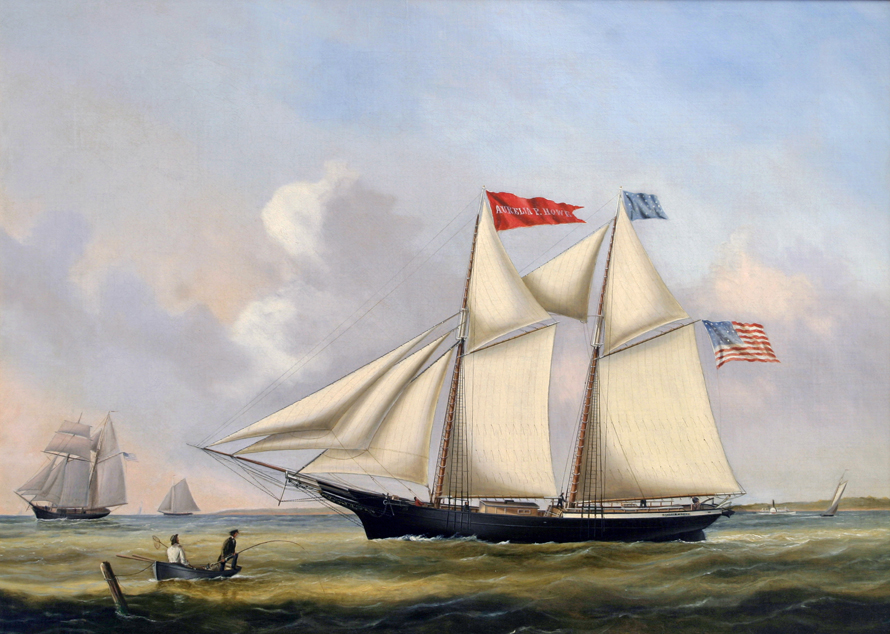The Sea, The Sea
To the uninitiated, they’re just paintings of ships on the ocean. Curator Joe Vallejo explains what makes the tradition of marine art romantic, enigmatic, celebratory.

Interview by Nozlee Samadzadeh
TMN: Why an exhibit of maritime painting?
Joe Vallejo: Romantic, mysterious, celebratory, and ever-present, marine paintings are a universal art form, bringing together people and cultures worldwide. They are captured moments of artistic beauty and historic significance, yet as diverse in subject and style as the artists who create them. Continue reading ↓
Joe Vallejo selected the grouping of historic works in the recent exhibit Important Marine and Maritime Paintings at Cavalier Galleries. All images courtesy Cavalier Galleries, Inc.













Interview continued
TMN: The works in this exhibit range from the 1700s to this year. What is a brief history of marine painting?
Joe Vallejo: Well, art of the sea is as old as humankind. In a quick analysis, Dutch artists in the 15th and 16th centuries began painting scenes on canvas in oil for royal patrons, and the practice spread to England. As their empires expanded over the oceans, so did the demand and desire for images of seafaring activities, naval conflicts, and vessel portraits.
With royal patronage, the artists’ works were sought by people of higher society standing, and by those with first-hand connection to the moments painted. This proliferation created a growing demand, and soon artists were working the various ports of the British kingdom, paintings not only such works, but the ever-growing merchant shipping trade as well. This occurred in the Mediterranean as well, and with different driving factors in China and the United States. Combined with the history of the artistic academies of France and the rest of Europe, the classification of a marine painting was widely expanded in the 18th and 19th centuries.
TMN: Were these paintings created in wartime or peacetime?
Joe Vallejo: Both. Again, the possible reasons for a painting’s genesis were numerous. Artistic vision and hired commissions both drove their creation. Epic national victories at sea were celebrated not only by the governments and ruling bodies, but by the everyday citizens who often were directly related to the men on board such ships.
Counter to this, we have yet to see someone who will not stand still to marvel at a spectacular sunset beyond a shoreline and not at least contemplate capturing the beauty of such in art. The public fascination with the birth of competitive yacht racing in America in the last half of the 19th century was another significant driving force for marine art, both of original works and images created for the ever-growing publications.
TMN: Where are these paintings taking place? What are those locations like today?
Joe Vallejo: Everywhere there is an ocean, a lake, or a body of water, there is the potential for a masterwork. Paintings often were of a captured special moment, held dear for the beauty of the remembrance as well as the artistic talent on display.
TMN: How has the style of this type of painting changed over time?
Joe Vallejo: The transition of art styles worldwide directly affected every generation of marine painters. The evolution of the active stylized seas of the Dutch, to the technical and highly detailed works of the British artists, and their associates in China and relatives in America continued to grow the variety of art styles. As Realism and Romanticism grew towards the birth of Impressionism in France and elsewhere, so it did as well with marine art.
Within Impressionism, marine art achieved a wider, public audience, and that hunger for works made possible the growth of marine art worldwide, and the birth of Luminism in British and especially in American paintings, which transcended from marine painting to all genres. By the arrival of Modernism and beyond in the 20th century, all these aspects have resurfaced and are in use by contemporary painters.
TMN: Historically, who was likely to own these paintings? What is the market for them like today?
Joe Vallejo: Kings and queens, paupers and parsons, the merchant sea captain and their landlocked cousins all owned marine paintings. With the exploration of the world throughout the centuries, the process of discovery became accessible to everyone, in literature and in art. People choose to own, first and foremost, works of art that appeal to their individual sensibilities. From there, the reasons expand exponentially—art is an essential part of life itself, and we all live just once.
